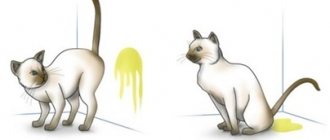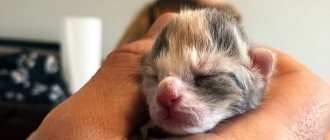Cats are delightful companions, but they can drive you crazy when they start marking furniture and other objects and your home starts to smell like a strong and disgusting smell of cat urine. Territory marking is a natural behavior for cats, but it should be limited as it can cause damage to your carpets, furniture and walls.
Cats, especially males, begin marking around six months of age. This time coincides with their puberty. Your pet may begin marking at this time to mark its territory. Spaying or neutering your kitten can reduce the chance by up to 95%.
Cats mark territory for a variety of reasons, from territorial behavior to medical problems. Read on to find out why and when cats mark and how to solve it.
Marking or urinating anywhere?
The cat leaves marks in the apartment using the odorous secretion of glands that are located on the face (cheeks, chin, around the eyes), paws, sides and anal area. The cat also marks surrounding objects with its urine.
This can happen during sexual hunting, when, if it is impossible to go in search of a sexual partner outside the home, the cat marks the territory with urine to attract him. If a cat suddenly starts leaving marks, it may be sick or unsure of the security of its personal boundaries. The pet shits everywhere to scare off strangers with a strong smell.
It’s easy to determine that a cat is not pooping in the wrong place, but is trying to mark territory in the apartment. During the process of urination, the animal sits down, lowering its tail. He chooses secluded corners for this, but can mark the carpet or bed. Cats usually leave scent marks on vertical surfaces. To do this, the tailed monster turns its back to the object that it wants to mark, straightens its hind legs as much as possible and makes a movement with its tail, similar to shaking, while spraying the object with a stream of liquid.
Cats also leave marks, but more often with their claws. Nevertheless, sometimes they also use urine, although in the case of a female it is difficult to understand that these are marks and not puddles made in the wrong places.
Fluffy marks things and shoes with urine
What should you do if your cat marks everywhere, including shoes and even clothes? Surely you were not prepared for such a development of events when you got a pet.
The fact is that the imperious purr does not care where his scent marks will be; the main goal is to inform competitors and surrounding people that there is no place for a stranger in this territory. As for shoes, they exude the aroma of human body and sweat. The animal will try in every way to drown out extraneous odors, replacing the aromatic bouquet of shoes that is unacceptable to it with urine marks.
How cats mark
There are sexual and reaction markings:
- Sex marking is characteristic of uncastrated males and females. This is how they attract a partner and talk about their availability. Urine contains pheromones, which “encode” information about the animal’s gender, status, and age.
- Reaction tagging is associated with anxiety. This means that something has changed in the place where the animal eats, drinks, and plays. The cat marks to leave a scent to mark “its territory.”
This division is arbitrary, because the labels often coincide.
Leading cats and animals that have to adapt mark equally often:
- Leaders leave their “business card” with a mark so that others know who is in charge.
- A timid, insecure cat marks when there are no people or animals nearby. According to one version, he shows aggression, which, due to fear, he cannot express in an open fight. According to the second, he reduces anxiety by making the area smell like himself.
Typically cats mark their territory by spraying a stream of urine. But they can also mark with feces and leave puddles. The latter is more often observed if there are other people's cats in the neighborhood. Then the domestic cat will leave puddles at the door in one place. Cats with access to the street mark trees, fences, flowers, and the ground.
Why does a cat mark?
Cats leave scent signals for their fellow cats. Due to the special structure of the urethra, they are able to spray liquid onto vertical surfaces. In nature, these are trees, large stones, etc., but at home, walls, doors and furniture suffer.
In addition to urine, the tags contain pheromones. These are substances by which one can judge the condition of the animal:
- his gender;
- age;
- state of health;
- readiness for mating;
- and so on.
That is, by spraying marks, cats simultaneously solve two problems. They call cats for procreation. And at the same time they inform the other cats that this territory is occupied. Often the same places are chosen for marks. If there are other animals outside the apartment, cats mark doors and windows more actively.
The cat marks the territory
Cats, like other domestic animals, need human affection and care. If you don’t show it towards them, then the reaction will be appropriate
Pets will begin to attract the attention of their owner. To do this, they can mark interior items
Why do castrated cats mark?
Mature cats mark most often. Occasionally, castrati do this, usually due to stress. Sudden changes in life can cause them anxiety and worry, for example:
- the arrival of a new pet or family member;
- moving;
- repair;
- rearrangement or replacement of furniture;
- an unpleasant guest who frightened the pet.
By leaving his scent, the cat is trying to regain his confidence. He seems to be telling himself and those around him that this is his territory. In such cases, you may notice other changes in behavior. For example, a cat hides more in inaccessible places, plays less, and eats worse.
Neutered cats mark due to stress
Problems with the tray
But urine in “wrong” places is not always a signal for other cats. Sometimes the reason for its appearance is related to the tray. If the litter box is dirty, uncomfortable, or contains stuff that is unpleasant for the animal, the cat may prefer to “do business” in another place.
To find out the reason, try to notice how it happens. If the cat turns its back to a wall or object and slightly twitches its tail, and the stream of urine is almost horizontal, this is a mark. And if your pet sits down, it means he is emptying his bladder. In this case, a puddle remains on the floor or horizontal surface. Urine smells less strongly because it contains less odorous substances.
The cat may not like the condition of the litter box
Urolithiasis disease
Another possible problem is urolithiasis. It hurts the animal to go to the toilet. And it tries to help itself by choosing a suitable place. And in the later stages, the cat does not always have time to run to the litter box, even if he tries to do so.
The position is different from the one that cats take during marking or normal trips to the toilet.
This is how healthy cats go to the toilet
A cat with ICD urinates in this position
There are other signs:
- licking the area under the tail;
- cloudy urine;
- blood in it (gives the liquid a pink tint of varying degrees of severity);
- frequent trips to the toilet with the release of a small amount of fluid.
Why do cats mark objects in the house?
Cats begin to mark their territory due to the influence of various irritating factors. Unlike cats, they do this much less often, so the owner may confuse the marking process with urination. The list of main reasons is as follows:
During illness, the pet can relieve itself outside the tray. The problem arises mainly due to the formation of kidney stones and the development of cystitis. The animal, on a subconscious level, gets the impression that the pain is manifested precisely because of the tray, so it looks for other places of fusion of need. The situation can be corrected, but to do this, the pet must be shown to a veterinarian. Otherwise, the disease will progress. Representatives of the cat family may mark their territory due to the arrival of a new person or another animal in the house. The pet will perceive such an update as a threat to its territory. The main instinct will advise him to mark objects, showing who is in charge in the house. If the problem is the arrival of a new family member, then only time will help. The cat must get used to the person in order to “accept” him. When getting another pet, you need to be prepared to share the house between them. Otherwise, there will be little chance of avoiding conflict. Sometimes a pet begins to mark objects as a result of another animal marking the front door. The owner will have to get rid of the foreign smell and try to prevent the situation from recurring.
There have been cases when a cat began to mark corners in the house after moving. For her, the new environment has not yet been explored, so instincts are triggered. Over time, everything returns to normal. After sterilization, the cat marks in the apartment due to the stress it has experienced. There is no need to scold her, since time must pass for the animal’s psyche to recover. In severe cases, you may want to consult with your veterinarian about giving a sedative medication to calm your pet's nervous system. A cat may mark its territory due to raging hormones. After reaching 7-8 months, it becomes a sexually mature individual. If a cat lives in the neighborhood, the female begins to mark the corners of the house, showing the boundaries of her possessions. The whole problem here is the activation of instincts, since against the backdrop of hormonal surges there is a fear of losing territory. Sterilization does not actually help in this situation. The animal returns to normal and continues to mark. The only salvation will be to get rid of the potential sexual partner, at least for the duration of the heat. There are situations when a cat has to be left with strangers. She begins to mark her territory as a sign of protest or simply due to stress. The animal’s behavior returns to normal only after returning to its familiar environment.
shutterstock
What else can provoke a neutered cat to mark its territory?
It happens that castrated cats mark in the apartment. What to do in this case? So, the castration was done on time, all the conditions seem to have been met, but your pet still begins to leave marks throughout the house. What other reasons could there be that provoke a neutered cat to mark his territory? There are several of them, the main ones are:
- Lack of attention;
- Severe stress;
- Any health problems;
- The appearance of another animal;
- The arrival of a new family member;
Let's take a closer look at each of these reasons, as well as how to eliminate them.
Lack of attention
Sometimes, when, for example, cats mark the door, this indicates that the animal lacks attention from the owner, and thus the cat tries to provoke the person into at least some kind of communication. Often this cause of marks is easy to eliminate: it is enough to devote more of your free time to the animal, and then the problem of marks will disappear after some time. Play more, actively communicate with the cat, and then he will have no time for marks - he will understand that the owner still loves him, and, most likely, will stop marking altogether.
Severe stress
It is also a very common reason for a cat to mark in the house. What to do in such a situation? Naturally, try to calm the animal down and return it to its familiar environment, if possible. An animal often experiences such severe stress during a move, or when its owners change. If it is not possible to eliminate the cause of stress, then you need to protect the animal as much as possible from worries, create peace and comfort for it, while paying as much attention as possible. Over time, these measures bear fruit - the animal will stop marking the territory of the home.
Health problems
Monitoring the health of your pet is your sacred duty, because if you have an animal, no one but you will worry about it. Therefore, before you wean your cat from marking in the apartment, you must keep an eye on the cat.
Perhaps his marks are just a way to draw the attention of the owners to any disease that is bothering the pet. If you have the slightest suspicion that something is wrong with the animal, you need to urgently contact a veterinarian
An experienced doctor will confidently say whether the disease was the cause of the marks, and will rule out the possibility of further development of the disease.
Appearance of another animal
If you decide to get yourself another pet, and you already have an adult cat, get ready for the fact that he will most likely begin to mark every corner, and the question of whether cats mark after castration will disappear by itself. The main reason for this behavior will, of course, be the cat’s territoriality - he wants to tell the stranger that everything here is entirely his habitat, and he does not intend to give it up to anyone. What to do in such a situation is an ambiguous question, and there is no single correct answer. Perhaps the cat will stop marking himself when he realizes that the other pet is not trying to remove him from his rightful possession. In any case, in such a situation you are unlikely to be able to influence the cat - punishing him for marks makes no sense.
The arrival of a new family member
The appearance of a new person in the house can also cause the cat to mark. What to do with the animal in such a situation? The answer is simple: nothing. You cannot change the very essence of cat nature - the cat suspects that the newcomer wants to deprive him by stealing part of the territory, and begins to actively mark all his possessions
Moreover, it does not matter at all: whether a child has appeared in the house, or whether a grandmother has simply come to stay - the animal perceives the new smell as a challenge to its authority. Over time, when the cat understands that he is not being kicked out and no one is encroaching on his bed with a cloth, he will calm down and stop leaving his foul-smelling traces
Third-party reasons for the appearance of marks
They can appear not only in spring, at the time of love and natural call. A pet will assert itself if:
- experienced stress;
- very scared;
- suffered a serious illness;
- changed his place of residence;
- saw another animal in the house;
- feels jealous of one of the family members.
In this case, you need to pay increased attention to him, stroke him more often, show your affection, talk calmly, in a low voice, with a friendly intonation. He will definitely respond to love and affection, replacing anger with mercy and confirming the opinion that he still remains the favorite of the household.
Why does a castrated cat mark its territory: what to do if the operation does not help?
This also happens: there are no testes, and the animal still only brings trouble to the owners, settling down to go to the toilet in places that are not intended for that. Sometimes there is more than one reason for this behavior. Let's look at the main ones to find a way out:
Will a cat mark after castration? Yes, if its physiology differs from the anatomical structure of other pets. We are talking about such a feature as cryptorchidism - in this case, the testicles (one or both) are not located in the scrotum, but are hidden under the skin - hidden in the groin area or in the abdominal cavity. Such an animal should be taken to an experienced veterinarian - a young specialist may not be able to find the gonads. Hence the consequences - the hormone testosterone is still released, which means the cat will continue to do its job - even after the removal of one testicle.
Do neutered cats mark territory? Yes, if the operation was performed at an advanced age. In other words, the appointment was made by an old man who was accustomed to leaving his marks all over the apartment, and even surgery would not be able to wean him off. In the animal’s brain there is a memory center that is responsible for preserving those very dominant signs that prompt them to once again go around their possessions and leave odorous marks. The way out of such a situation is a timely visit to the veterinarian.
Having other pets is another reason that should not be forgotten. Especially if all four-legged residents of the house are males. In this case, multiple tracks are a natural struggle for a dominant position. Animals sense the smell of their rival neighbors and try not to yield to them in anything.
So, we answered the question of whether cats mark in an apartment after castration, but we still haven’t said what to do in such a situation. There are several options:
The first is to remove the remaining testicle if cryptorchidism is confirmed in the pet. To do this, take your pet to a trusted specialist - experience with such congenital anomalies plays a big role. The successful outcome of the operation depends on him.
The second is the use of special drugs that repel cats and discourage them from marking in the apartment. Antigadin spray is one of these products. For most owners, this is a real lifesaver, but each case is individual - a positive effect may not follow.
The third is contacting a zoopsychologist. It will help change behavioral reactions, suppress the desire to leave marks on furniture, floors and clothes, and free your pet from the habit of going to the toilet anywhere but in the litter box.
Fourth, sometimes changing apartments helps. These are extreme measures - it is unlikely that anyone will want to move because of the smell, which will disappear after cleaning. However, in some cases, a change in area actually leads to a complete abandonment of the desire to confirm its dominant position.
In this article, we talked about when (at what age) cats begin to mark their territory, what are the reasons for this unpleasant phenomenon for their owners, and what to do for those who do not want to put up with the persistent smell of urine in the apartment. There is no universal advice - an individual approach is required. However, a better method of solving the problem than castration during puberty has not yet been invented.
Time to leave traces: when does it start?
Do all cats mark and at what age do they start spraying urine wherever they want? Everyone is individual - it depends on the breed, conditions of detention, nutrition. However, most often the active struggle for every free corner begins at about eight months.
As cats mature, their desire to mark only increases. Not only the pet’s body changes, but also its habits, and the desire to dominate other males in search of a female increases. Aggression towards rivals appears in the character. The animal thinks that the struggle for territory is a matter of time, and begins to mark it. The result of such efforts is the acrid smell of urine that appears wherever the pet lifts its tail.
Such activity and reluctance to re-educate is a cause for grief for many owners. They are used to seeing their cat as a cute animal, a fluffy ball that evokes exceptionally tender feelings. However, constant cleaning can turn love into hate and tire even those who don’t mind walking around the house with a mop and rag.
Alas, such behavior is inevitable and quite natural for our four-legged friends. What time do cats start marking? As soon as puberty begins. It is this period that most owners wait with trepidation: they are already anticipating constant cleaning after their pet. The age of transition to adulthood is different for all breeds:
- For animals of the eastern group (Siamese, Oriental, Thai) - approximately 6 months.
- For Siberian, Maine Coons and other large pets – 7-9 months.
Age characteristics of cats
When people take home a cat, they immediately think about where to put the kittens. When bringing a cat, many do not remember that it will grow up and begin to mark its territory. There is almost no smell from the little animals, they get used to the tray without any problems, carefully doing their business and even notify the owners using their own cat-like methods that it is time to change the litter.
The maturation of an animal is accompanied by significant restructuring of the body, the emergence of new functions, including a sense of ownership. This is a completely normal phenomenon, since the cat family is a predator, which they regularly remind owners of by bringing a mouse or scratching the sofa upholstery with their claws in anticipation of a successful hunt. But the main indicator that the animal has become an adult and reached sexual maturity is the beginning of marking its territory.
Important: the pungent odor of the marks is due to a high concentration of pheromones. The composition of odorous marks differs from a normal visit to the toilet
They contain a small amount of urine, fairly diluted with pheromones and seminal fluid. Thus, the cat declares rights to the territory and readiness to mate. Maturation depends on the breed and general physical condition of the animal
The composition of odorous marks differs from a normal visit to the toilet. They contain a small amount of urine, fairly diluted with pheromones and seminal fluid. Thus, the cat declares rights to the territory and readiness to mate. Maturation depends on the breed and general physical condition of the animal.
In free-range conditions, the cat marks the adjacent territory, leaving odorous information on the fence, trees, and corners of the house. But in the apartment such a heavy smell, which practically cannot be washed off or ventilated, becomes a real problem. Finding the source is difficult because it is practically invisible against the background of the floor. And if the jet hits the upholstery or curtains, it will not be possible to remove the consequences immediately.
Call of nature
No matter how well a pet is raised, it is difficult to cope with instincts. And the labels refer specifically to them. The process looks recognizable: the cat approaches any vertical surface around the perimeter of the room, turns its back, lifts its tail and twitches it, releasing a small stream with a very pungent odor. In this way, he informs others about his rights to the territory, notifying the surrounding females that he is an adult dominant male, ready for courtship and procreation.
The strength of the manifestation of instinct does not depend on the living conditions of the animal. In a domestic cat it is as pronounced as in a wild relative.
Desire for dominance
If there are several cats in the house, the situation becomes more complicated. As soon as one of them starts the process, the avalanche will roll onwards. They argue for supremacy not only through fights and wild meows, but also by stubbornly interrupting the opponent’s marks. Until the leader of the house is determined, the rivalry will continue.
Despite the freedom-loving character of the animal, it recognizes the dominant male. To do this, you need to catch the ugly guy red-handed, poke him with his nose and shake him vigorously, holding him by the scruff of the neck. If he responds with a quiet meow, then one can hope that he has recognized a stronger opponent and the marks will stop. The method is untested and depends on the breed and character of the pet.
Signs of growing up
It is difficult to focus on generally accepted norms in the case of a cat. The average age of entry into adulthood is after six months. Particularly early ones show the first signs by 5 months, some linger until 8-9 months or longer.
Outwardly, the outline of the muzzle changes, the cheekbones become sharper, the muscles appear prominently on the body, it becomes denser, leaner, and the special grace of a swift predator appears in its movements. The imminent appearance of the marks is announced by the calling cries with which the matured individual lures a potential partner.
Observe the visit to the tray
Be sure to take time and see how your pet behaves around him. If he:
- Places the front paws on the edge of the tray or completely, they remain outside it.
- It is not the filler that scrapes, but the rug on the floor.
- Does not bury its waste products in the contents of the tray.
All this suggests that using this device is inconvenient for him. You need to either choose a larger tray or change the filler. It happens that it is too large and the pet does not like it.
How to stop a cat from marking in the entrance
There are different ways to stop a cat from marking at the entrance:
- Neuter all animals living in the area. This, of course, is a difficult but radical measure to combat cat marks.
- Place a door in the entrance, thereby preventing access of unauthorized animals to the premises.
- Regularly treat surfaces (walls, floors, handrails, etc.) with products with a repellent effect.
We recommend reading about how to punish a cat depending on its age. From the article you will learn when to punish a pet, methods of punishment, and options for correcting the causes of bad behavior.
And here is more information about why a cat shits on the bed.
Cat marks are a manifestation of the self-preservation instincts of animals inherent in nature. It is quite difficult to prevent a negative phenomenon. The only way to combat territorial marks in cats is early castration before signs of puberty. In adults, it is impossible to completely eliminate unwanted behavior. Proper upbringing and compliance with hygiene measures comes to the aid of the owner.
Why does a pet mark?
The reasons why a pet may suddenly begin to mark various surfaces in a house or apartment are varied. Let's look at the three most common ones.
Instinct
A domestic cat may begin to mark its territory for natural reasons. Being a territorial predator, these furry animals have an instinct that pushes them to damage things and furniture. Thus, the animal protects its territory from the encroachments of its relatives.
You need to understand that instinct is very difficult to fight. But you can still change your pet’s behavior for the better. What needs to be done for this will be described below.
When other animals or strangers appear in the house, the cat may begin to place its marks in the corner of the room. Moreover, a neutered pet can also exhibit this behavior.
This behavior may go away on its own when the animal gets used to the stranger. Give your pet time, and he will calm down on his own and get used to the new environment.
We suggest you read: How to determine the breed of a cat or kitten: online identification by cat color
Not all cats begin to mark surfaces when strangers appear in the house. This is usually done by restless animals that react strongly to external factors.
Illness and stress
Specific markings may appear anywhere in the house if the pet is sick or under extreme stress. Moreover, this phenomenon does not depend on age, gender and breed.
These animals experience stress when moving, long journeys, protracted illness, frequent and prolonged absence of the owner, etc. Therefore, you should always pay enough attention to your four-legged friend, since it is very difficult to wean him from a bad habit.
If a young animal lives in the house, it will be useful for the owner to know in advance what to do to prevent the cat from marking the territory. First of all, the animal begins to perform such actions that irritate household members at the age of 6 - 10 months. Small kittens do not mark their territory until puberty. Therefore, the owner should carefully monitor the appearance of signs of puberty in a young male.
It is almost impossible to prevent the manifestation of natural instincts, but proper training of a pet from the first days of its stay in the house will help to avoid negative behavior in the future.
First of all, the little kitten needs to make it clear who is in charge in the house. An animal should not be raised in permissiveness; this will confirm the young male that he is the leader.
If the cause of cat marks is boredom and loneliness, the owner should make an effort and pay enough attention. In the absence of the owner of the house, it is advisable to purchase a gaming complex and leave toys for the cat.
The owner should understand that neither shouting, nor assault, nor throwing slippers and other objects at the cat will have any positive effect. On the contrary, the animal will become convinced that its self-preservation is threatened, and the actions of leaving marks will become more active. Therefore, in the matter of weaning a male from behavior that is unseemly from the point of view of household members, there should be no forceful influence.
Duration and frequency of sexual heat
In the very first days of estrus (1-4 days), the cat demonstrates sexual arousal, but does not allow mating.
This time is called proestrus, “forerunner”. Unlike dogs, cats do not have a clear boundary between estrus and proestrus, and it is difficult to determine these periods. If sexual intercourse does not occur during estrus, then ovulation does not occur. In this case, sexual heat returns every 10-14 days. The period between estrus is called interestrus, this is a time of rest for the uterus and ovaries. In some cats, the concentration of estrogen in the blood does not decrease, and the animal walks constantly.
Complete rest of the ovaries, which means the absence of the reproductive instinct, is called anestrus, the absence of estrus. In stray cats, this period occurs in late autumn or winter, due to short daylight hours and the action of the hormone melatonin. Anestrus does not occur in domestic cats due to constant light and nutritious food.
A distinctive feature of the breeding system in cats is induced ovulation. Simply put, an egg is released from the ovary only in response to vaginal stimulation. Natural ovulation occurs due to mating, but artificial ovulation is also possible - as a result of manipulations in the vagina.
Ovulation occurs 1-2 days after intercourse, and after another 1-2 days the estrus stops. The ovary forms the corpus luteum, which produces the hormone progesterone to maintain pregnancy.
If the egg is released and fertilization does not occur, progesterone will be produced “by inertia” for 1-1.5 months (less than a true pregnancy). Progesterone prevents the resumption of estrus.
We suggest you read: Large breeds of pigs - choice for breeding
In cats, sexual function does not decline until death; even at 16-19 years of age, estrus is observed from time to time in non-sterilized animals.
I'm 14 years old, motherfucker, how old can you be?
How to wean a pet?
There are different ways to stop a cat from marking its territory.
Folk remedies
In the wild, it is a strict rule that only privileged individuals can mark territories. If younger members of the family begin to encroach on this right, the head will definitely show who is boss in the house. In order to wean a cat from marking territory, you need to be able to communicate with him using sounds and gestures with which he communicates with other cats.
If you notice that the cat has raised its tail and is about to make a mark, you need to take it by the scruff of the neck with one hand and wait until it takes the pose of a small kitten, which the mother cat holds in her teeth: she tucks her tail to her stomach.
Next, you need to show the cat who is in charge. To do this you need to show some acting skills. The actions of the cat owner consist of the following steps:
- You need to start imitating a cat's hissing with a menacing look. The sound should resemble the word "fshih". Thus, you need to “hiss” at your pet for as long as possible, without interruption, making frightening sounds.
- Next, you should simulate a cat fight. Remember how they alternately hit their opponent's face with their paws. It is necessary to repeat these movements with your fingers, without making much effort, so that the animal does not hurt.
- You should make movements feigning anger. You need to be really angry, otherwise your pet may feel that he is being deceived. Even the smell can give it away, by which they are good at determining the emotions of their opponent. If you are angry and call your cat in a gentle voice, it will never come because it will sense deception. Likewise in this case.
- When striking, you need to look into the cat's eyes. In the animal world, looking into the eyes is a challenge: whoever looks away first admits defeat. That is why cats do not catch up with their opponent and do not enter into a fight with him if he looks away.
You need to strike the face with your fingers, make a menacing hiss and look the cat in the eyes until he starts squeaking and looks away. From now on, in the eyes of the cat, you are the head of the family and he is obliged to obey. If the animal turns out to be wayward and continues to make marks after the first procedure, you need to repeat the session after a while until the desired result is achieved.
Valuable advice from owners and breeders
One of the methods for weaning a cat from marking territory in an apartment is castration and sterilization. After the operation, the marking instinct disappears in 80% of animals, and in 10% it decreases after a certain time. If castration, sterilization and the methods described above do not help, you can resort to drug therapy.
Most medications contain progestin, a female hormone, and tranquilizers, such as Valium. The drugs are taken orally or given by injection. The result of treatment is suppression of the marking instinct. True, side effects may occur: weight gain, diabetes, passive behavior.
If you breed cats, the likelihood that the male will mark increases during the female's heat. Therefore, breeders advise keeping the male separately. In a house where there are many animals, it is advisable to give each one its own box, where the animal can be alone. To prevent the cat from marking, you can place a bowl of food next to the marked territory; cats are neat, so they don’t mark where they eat.
How to stop a cat from marking territory outside in a private house
You can wean a cat from marking territory on the street in a private house in two ways - by distraction and scaring away. You can distract from an unwanted habit by setting up a special corner for your naughty pet. For this purpose, you need to choose a suitable place in your garden and cover it with sand, in which cats love to dig. To make the corner attractive to the animal, you can plant catnip around its perimeter.
You can stop your cat from marking his territory by using repellents. You can purchase special liquidators and tag destroyers at the pet store. The products have a repellent effect and can be used to treat different surfaces.
A remedy to prevent a cat from marking in the apartment
To prevent the cat from marking in the apartment, special means will help:
- to calm the cat (tablets Kot-bayun, Fitex, Stop-stress, folk remedies use citrus fruits - lemon, orange, as well as laundry soap, wormwood, ammonia and hot spicy seasonings - pepper, turmeric);
- neutralizing the pungent odor of cat urine (the same citrus fruits and laundry soap, bleach solution).
Tablets, drops
Experienced breeders recommend giving your pet plant-based calming tablets, for example: Kot-bayun, Fitex, Stop-stress. These drugs have a sedative effect and help the cat behave more calmly. However, sedatives do not work on all animals.
Inexperienced owners often resort to hormonal contraceptives in the form of drops, for example, Sex Barrier. However, veterinary experts argue that such products are harmful to males and do not eliminate the problem of territory marking.
Folk remedies
Among folk remedies, citrus fruits are most often used to combat unwanted animal behavior. The aroma of lemon and orange not only neutralizes the unpleasant odor, but also discourages the animal from marking its territory. The herb wormwood and coleus can help cope with the problem. Laundry soap has a good neutralizing effect.
Furry fidgets do not like strong-smelling substances, and they avoid the treated areas. Ammonia, which has a pungent odor, will help stop you from marking your territory. Spices have a similar effect - red and black pepper, turmeric, cayenne pepper, mustard powder.
Watch this video on how to stop a cat from marking in the apartment:
Preventive measure
It’s difficult to fight nature, but cat owners have developed a few tricks.
- Animals usually choose certain points to which they return with enviable regularity. These places are rubbed with lemon, the approaches to them are treated with red and black pepper powder.
- The animal care industry has developed a number of special products in the form of sprays, drops, and powders. They are designed to discourage marking, but their effectiveness often depends on the cat’s preferences. What worked for your neighbors may not work for another pet.
- Replacing the tray may also solve the problem. Sometimes the animal is simply uncomfortable with the size or does not like the structure and smell of the filler. This is indicated by the pose of the animal, when its front paws are on the floor, it tries to bury the results of its activity, scraping the rug with its paws.
You should know: the most decisive measure against the appearance of marks in an apartment is castration.
It is carried out without waiting for the animal to grow up, if there are no plans to search for cats for breeding or to organize free walking for the pet. In an adult state, it is pointless to carry out it; the animal will continue to leave marks out of inertia.
The operation is simple, healing occurs very quickly. The benefits include stopping damage to furniture and wallpaper, reducing the animal’s aggressiveness, maintaining a playful disposition, prolonging the pet’s life, and eliminating genitourinary infections. The most important thing is that there are no marks or heavy smell in the room.











